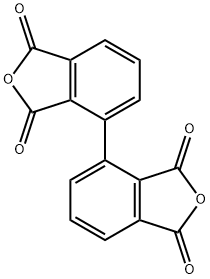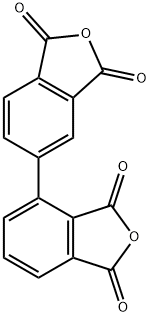
Product Details:
CasNo: 3711-04-4
Molecular Formula: C16H6O6
Appearance: White to off-white Powder
Packing: Aluminium bag
Throughput: 10000KG/Month
Purity: 99%
4-(1,3-dioxo-2-benzofuran-4-yl)-2-benzofuran-1,3-dione belongs to the class of aromatic dianhydrides containing a benzofurandione structure. The core applications of such compounds focus on the field of high-performance polymer synthesis, particularly suitable for the preparation of special polymer materials like polyimides. Combined with the characteristics of the materials industry, the specific application scenarios are summarized as follows:
1. Synthesis of High-Performance Polyimide Resins
This is the most core application of this type of aromatic dianhydride compound. It can act as a monomer to undergo polycondensation reactions with aromatic diamines, producing polyimide materials. Due to the presence of rigid benzofuran rings and imide bonds in its molecular structure, the synthesized polyimides exhibit outstanding high-temperature resistance, excellent mechanical strength, and good dielectric properties. Such polyimide resins can be further processed into films, composite material matrices, etc., and are suitable for the manufacturing of key components such as high-temperature resistant structural parts in the aerospace field and insulating films in the electronic field.
2. Preparation of Modified Copolymers such as Polyetherimides
It can undergo copolymerization reactions with monomers containing flexible structures (e.g., ether bonds, ketone bonds) for modifying polymers like polyetherimides and polyamide-imides. By adjusting the addition ratio of this monomer, key properties of the copolymer such as glass transition temperature (Tg) and melt viscosity can be flexibly regulated. This not only retains the core advantages of the material in heat resistance and mechanical performance but also improves its processability, making the material easier to process into industrial and medical components (e.g., automotive electronic housings, high-end medical device housings) through processes like injection molding and extrusion.
3. Matrix Precursor for High-Performance Composite Materials
In the field of advanced composite materials, polymers synthesized from this compound can serve as resin matrices for composite materials, which are compounded with reinforcing materials such as carbon fibers and glass fibers. The resulting composite materials combine the characteristics of lightweight, high strength, and high-temperature resistance, and can be applied in high-end equipment manufacturing (e.g., insulating components of large motors, structural composite materials for high-speed aircraft). They effectively enhance the operational stability and service life of the equipment.
4. Research Reagent in Academic and Materials R&D Fields
Thanks to its unique aromatic dianhydride structure, this compound is also an important reagent in materials science research. Researchers often use it to explore new polymerization mechanisms or develop novel functional polymer materials—for example, studying special polymers suitable for extreme environments (e.g., high radiation, strong corrosion scenarios), providing an experimental foundation for expanding the application boundaries of polymer materials.
Overall, monomers containing the benzofurandione structure focus on high-end manufacturing and scientific research fields with strict requirements for material performance. The performance advantages of the polymers synthesized from them make them irreplaceable in replacing traditional ordinary polymer materials and improving the core performance of products.
Relevant Products
-
Decanoyl/octanoyl-glycerides
CAS:65381-09-1
-
α-BPDA
CAS:36978-41-3
-
4-PEPA
CAS:119389-05-8








